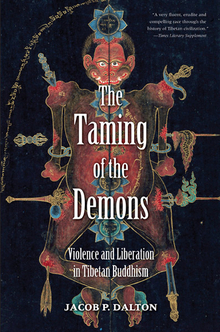The Taming of the Demons
WARNING
You are viewing an older version of the Yalebooks website. Please visit out new website with more updated information and a better user experience: https://www.yalebooks.com
Violence and Liberation in Tibetan Buddhism
Jacob P. Dalton
The Taming of the Demons examines mythic and ritual themes of violence, demon taming, and blood sacrifice in Tibetan Buddhism. Taking as its starting point Tibet’s so-called age of fragmentation (842 to 986 C.E.), the book draws on previously unstudied manuscripts discovered in the “library cave” near Dunhuang, on the old Silk Road. These ancient documents, it argues, demonstrate how this purportedly inactive period in Tibetan history was in fact crucial to the Tibetan assimilation of Buddhism, and particularly to the spread of violent themes from tantric Buddhism into Tibet at the local and the popular levels. Having shed light on this “dark age” of Tibetan history, the second half of the book turns to how, from the late tenth century onward, the period came to play a vital symbolic role in Tibet, as a violent historical “other” against which the Tibetan Buddhist tradition defined itself.
“This well-documented study is a great contribution to our understanding of how Tibetan Buddhism was formed and goes a long way to explain some of the more unusual aspects of this tradition. Dalton’s work displays impressive scholarship and provides a very innovative and original take on an important and yet not well-understood aspect of Tibetan Buddhism. It will be an important book.”—Georges Dreyfus, Williams College
“Shining a light on esoteric texts from the seldom-studied “dark” period of Tibetan Buddhism, this important book follows their ritual and rhetorical legacy into modern times, bringing us face to face with one of the greatest challenges to our interpretive abilities in all of Tibetan religious history. The incisive questions it raises, not only about the difference between symbols and the real, but also the very valence of violence in the religious – and ethical -- life of humankind, will be ours to ponder for a long time.”—Janet Gyatso, Harvard University
“Jacob Dalton's Taming the Demons is the single best book to date on Buddhists' (and especially Tibetans') struggle to come to terms with the religious sanctioning of violence. Staggering in its breath, and covering 2000 years of Buddhist textual history, the book explores Buddhist attitudes toward violence in literature as diverse as Indian monastic texts, tantric myths and rites, moral treatises, biographies, and legal speculation. A major contribution to our understanding of Buddhism.”— José Ignacio Cabezón, UC Santa Barbara
Shortlisted for the 2012 Academy of Religion Book Awards in the Historical Study of Religion category.
Publication Date: January 8, 2013
6 b/w illus.








